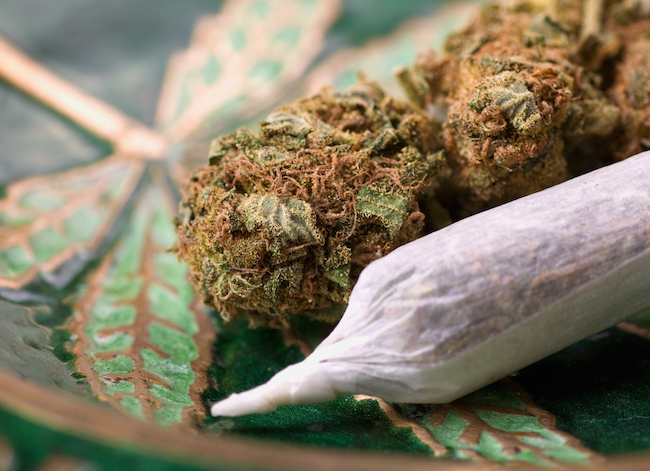Pot Science: Top Marijuana Findings of 2015

Researchers who study marijuana made a number of findings in 2015, from learning about the health effects of using the drug frequently and recreationally, to figuring out which diseases and conditions are most likely to benefit from the substance's use.
The findings about marijuana that came out this year advanced the science, even if only incrementally, said Alan Budney, a professor of psychiatry at the Geisel School of Medicine at Dartmouth in Lebanon, New Hampshire, who studies behavioral treatments for reducing or quitting marijuana use. "It was perhaps more of a year of identifying important questions in need of answers," he said.
A current major area of research investigates how the changing laws in some states governing marijuana use will affect rates of the drug's use, including rates of problematic use, Budney said.
"A study this year published in the journal JAMA Psychiatry raised lots of eyebrows when it found a doubling of marijuana use among American adults and almost a doubling of problematic use between 2002 and 2013," Budney told Live Science. Earlier studies of adult marijuana use had showed a much smaller increase.
Researchers are now wondering whether increased marijuana use will bring more problems, or if it will lead to fewer problems in other areas of addiction, such as alcohol, he said.
Another big concern in the field is the increase in sales of high-potency products, arriving with the advent of marijuana dispensaries in some states. "Little is known about the impact of these high-potency products compared with the lower-potency marijuana that people may have been using in the past 30 years," Budney said. It's too early, using the data that's currently available, to know the effects, he said.
Researchers know that high-potency marijuana products are different than their low-potency counterparts. But what's not known are what consequences may follow if more people have easier access to these stronger products, Budney said. The products may increase problems with toxicity, make users more prone to accidents and errors in judgment, and make more people vulnerable to addiction, he explained.
Get the world’s most fascinating discoveries delivered straight to your inbox.
Some of the hottest areas of research are investigating marijuana's short- and long-term effects on the brain, especially how use of the drug alters the course of brain development in teens, Budney said. Another hot topic is understanding the therapeutic benefits of compounds in marijuana used for medical reasons. [11 Odd Facts About Marijuana]
Although studies are beginning to show that some ingredients in marijuana are likely to be helpful for people with certain conditions, the findings have yet to nail down the specifics about the dose, the frequency, the best form to take (such as getting the active compounds from edible products or smoking it), the risks from frequent use, and whether marijuana works as well as or better than other available treatments, Budney said.
Here is a year-end roundup of the marijuana stories covered by Live Science in 2015, in case readers missed them.
1. More people are using the drug
Marijuana use in the United States more than doubled between 2001 and 2013, according to research reported this year in the journal JAMA Psychiatry. Over this 12-year period, the estimated number of U.S. adults who had used marijuana in the previous 12 months grew from 4.1 percent in 2001 to 9.5 percent in 2013. Marijuana-use disorders, which include problems with drug addiction and dependence, also rose, increasing from 1.5 percent of the adult population in 2001 to 2.9 percent in 2013, the study showed.
The researchers speculated that changes in drug laws and a rise in more permissive attitudes toward marijuana are contributing to increased usage.
In addition to the growing use of marijuana among adults, a 2014 survey of more than 1,000 U.S. college students found that the percentage of students who smoked marijuana every day or nearly every day reached its highest level in more than 30 years.
The survey found that 5.9 percent of college students said they had smoked pot 20 or more times in the past month, making near-daily marijuana use more common on college campuses than near-daily smoking of cigarettes. For comparison, 5.2 percent of students reported they had smoked cigarettes 20 or more times in the past month, according to the study.
The researchers said they suspect the rise in marijuana use is linked with college students' perception of the drug as being less dangerous than other drugs, as well as the increasing number of states that have legalized the substance's use for medical or recreational purposes.
2. New insights into conditions helped by medical marijuana
Researchers at the University of Bristol in the United Kingdom reviewed almost 80 previous studies that involved a total of about 6,500 people. The investigators concluded that medical marijuana may offer some relief for people with cancer-related pain, nerve pain or muscle spasms caused by multiple sclerosis.
The review, published in June in the Journal of the American Medical Association (JAMA), also suggested that cannabinoids, compounds found in marijuana, eased chemotherapy-induced nausea and vomiting better than a placebo. However, better-quality studies are needed to know for sure, the researchers said.
The analysis did not find evidence to support the use of medical marijuana in people with depression, psychosis, anxiety disorders, sleep problems, Tourette syndrome or glaucoma.
However, many of the studies that found that the drug had little to no effect on helping people with these disorders were small or poorly designed, and so larger and more rigorous studies are needed to look at its effects, the researchers said. This is especially true now that the use of medical marijuana is legal in 23 states and the District of Columbia, the researchers said.
3. Unforeseen risks of medical marijuana
The majority of edible medical marijuana products that researchers at Johns Hopkins University in Baltimore tested in an analysis this year were inaccurately labeled. Only 13 of the 75 tested pot food products — such as baked goods, beverages and candy — bought from dispensaries in California and Washington state had labels that accurately listed the amount of tetrahydrocannabinol, or THC, in them, according to the research, published in June in the journal JAMA.
Another study found that having more medical marijuana dispensaries in a neighborhood was linked with higher rates of hospitalizations for marijuana abuse or addiction. The research found that for every pot shop located within a square mile (2.6 square kilometers) of a given California zip code, there was about a 7 percent increase in the number of hospital stays related to marijuana use.
It's unclear whether it's the presence of the dispensaries within the community that's leading to the rise in hospital stays, or whether the stores are setting up shop in neighborhoods that already have underlying marijuana problems — or if both of these reasons are true, the researchers said.
4. Marijuana and the teenage brain
Several studies published in the journal JAMA Psychiatry in August offered insights into marijuana's effects on young brains. The findings suggest that a young person's genes and environment, and the frequency of drug use could all play a role in the way smoking pot affects a teenager's brain, but teasing out the actual differences is complicated.
One study looked at brain scans in pairs of same-sex siblings (who have half their DNA in common), including some sets of twins. Among the siblings, there were pairs in which both teens had smoked pot, while in other pairs, neither sibling had used the drug, or one teen had tried it while the other hadn't. The researchers found that teens who had smoked marijuana — even once — had smaller brain volume in the amygdala compared with teens who never tried pot. This brain area is involved in processing emotions and seeking rewards.
In another study, of more than 1,500 teenage boys, scientists compared the brain scans taken when the boys were nearly 15 years old to a second scan done when they were nearly 19. During this four-year period, the boys who had smoked pot and also had genes that increased their risk for schizophrenia had thinning in the cortex, the brain's outer layer, the scientists found. The findings suggest that marijuana could play a role in this cortical thinning, which may alter brain development in the teens, the researchers said. [10 Facts Every Parent Should Know About Their Teen's Brain]
5. Additional probing of marijuana's effects on the brain
A study done this year on the brains of mice offered a clue about why smoking pot may fuel hunger and bring on the munchies. The researchers examined the behavior of certain nerve cells, known as POMC neurons, which normally release chemicals that promote feeling full. These neurons switch to releasing chemicals that promote hunger when activated by the cannabinoids in marijuana, the researchers found. But these findings, and the proposed mechanism, need to be confirmed in human studies, the scientists said.
Another recent study found that THC, the active ingredient in marijuana, can increase random nerve-cell activity, known as "neural noise," in the brains of healthy people. The researchers suggested that at doses equal to about half or one joint, THC may produce psychosis-like effects and increased neural noise, which disrupts the brain's normal information-processing mechanisms.
6. Marijuana is not for kids
Between 2003 and 2013, the rates of accidental exposure to marijuana in children under age 6 in the United States increased by about 1.5 times, according to an analysis from researchers at Nationwide Children's Hospital in Columbus, Ohio. More than three-quarters of these exposures involved kids younger than 3, who accidentally swallowed pot, likely found in marijuana brownies, cookies and other food products, the researchers said.
The data also showed that exposure rates in young children climbed an average of 16 percent a year over the study period in states that legalized marijuana, compared with a rise of about 5 percent in states where pot remained illegal.
This supports the idea that the time after legalization of marijuana is a vulnerable period for youngsters, the researchers said.
More evidence of the potential of marijuana food products to confuse and harm young children came from another study, which raised concerns about the risks of candylike marijuana products packaged to resemble popular sweets. These products, which are legally sold to adults in Colorado, Washington, Oregon and Alaska, may contain four or more times the amount of THC that is safe to consume in a single serving. This makes them especially dangerous for young kids who may mistake the products for ordinary sweets, the researchers said.
Research like these two studies may help explain why the American Academy of Pediatrics (AAP) opposes the legalization of marijuana for medical or recreational use. Concerned that the increased availability of marijuana to adults could also increase access to and use of the drug by teens, the pediatrics group released a policy statement early this year outlining its position. In the paper, the group called for strict regulations on advertising marijuana products to young people and for restricting the drug's sale to individuals 21 and older.
Although the AAP is generally opposed to the use of medical marijuana, they made one exception, allowing for the use of FDA-approved drugs containing synthetic cannabinoids to children with debilitating or life-limiting diseases.
The potential problems with children gaining access to marijuana in states where it has been legalized for recreational use are illustrated in a tragic case report released this year. The report, published in July by researchers at the Centers for Disease Control and Prevention, described a 19-year-old boy in Colorado who was given a marijuana cookie that his 23-year-old friend had purchased. The friend told the teen a salesperson had advised him to divide the cookie into six pieces, and eat the pieces slowly over time. That was because each piece contained about 10 milligrams of THC, the recommended serving size of the drug's active ingredient set by the state.
The boy ate just one piece of the cookie as instructed, but about an hour later, when he didn't feel any of the drug's effects, he ate the rest of the cookie. Within 3 hours, the teen jumped to his death off the fourth-floor balcony of his apartment building, a victim of marijuana intoxication, the report said.
7. People are finding "new" ways to get high
Over the last three years, more marijuana users have been experimenting with "dabbing," which involves inhaling the vapors of butane hash oil, a concentrated form of marijuana, according to a study published this year by researchers at the University of North Carolina at Charlotte.
The oil is more potent than regular cannabis because it has much higher concentrations of THC. And dabbing it is considered to lead to a stronger, faster high that is at least four times as strong as smoking a joint, researchers said. But this emerging trend can bring additional dangers, because little is known about the health effects or risks of dabbing. [4 Myths About E-Cigarettes]
About one in five high school students who uses e-cigarettes has also tried using the devices to vape pot, reported a study of nearly 4,000 teens in Connecticut that was published in September. Whether the usage patterns observed in this one state reflect youth trends nationally is unknown, the researchers said.
Part of the appeal of vaping pot for teens may be that the practice masks some of marijuana's strong smell. But little is known about the health effects of vaping marijuana versus smoking it, particularly on a teen's developing brain, the researchers said.
8. Pot's unexpected health effects
When people light up a joint or take a few hits from a bong, its possible they're thinking more about the immediate gratification than the long-term consequences of using the drug. But this year, researchers shed some light on marijuana's potential health risks down the road.
One surprising finding was that young men who smoked pot more than once a week had sperm counts about 30 percent lower, on average, than guys who used the drug less frequently or not at all. The researchers said, in their study published in August, that they suspect a reduced sperm count may be linked with the way THC, the chemical in marijuana responsible for the drug's psychological effects, may interact with certain receptors found in the testes.
A possible dark side of marijuana was also illuminated in a German study published in May that linked the recreational use of pot to delusions that can last as long as one week. Recreational users may also experience such undesirable side effects as swelling in the mouth, a rapid heartbeat, vomiting, lung irritation and chronic bronchitis, the review reported.
Another unwanted side effect of marijuana is that it may trigger allergic reactions in some people who are sensitive to the plant's pollen, its smoke or the mold that could develop during storage, a study published in March reported. It's still a relatively uncommon cause of allergies, but the number of people who sneeze, cough or get a runny nose when exposed to marijuana may be on the rise as more states legalize the drug's recreational use in adults, the researchers speculated.
9. How weed affects the waistline and blood sugar
Smoking pot can temporarily boost appetite, and research done this year has found that regular marijuana users, especially men, might pack on the pounds.
Young men who smoked pot regularly, but did not smoke cigarettes had greater weight gain than men who smoked pot less frequently and also avoided cigarettes, the researchers found. (Many people who smoke pot often also smoke cigarettes, the researchers said, but the net effects of this are unclear — chemicals in marijuana stimulate appetite, whereas the nicotine in cigarettes typically curbs appetite.) [8 Reasons Our Waistlines Are Expanding]
In a different study, marijuana use was found to increase a person's risk of developing prediabetes, a condition in which blood sugar levels are higher than normal but not yet considered type 2 diabetes. The analysis, published in September in the journal Diabetologia, found that people who used marijuana 100 times or more as young adults were 40 percent more likely to develop prediabetes in middle age compared with individuals who never used the drug.
Although frequent pot use was linked with a greater risk for developing prediabetes, it was not tied to a greater risk for type 2 diabetes, for reasons that remain unclear, the researchers said.
10. Science investigates the safety of smoking pot
Marijuana is less dangerous than at least 10 drugs, including drugs that are legal to use, like alcohol and tobacco, found a study that was based on data from animal studies and not humans.
Alcohol topped the list as the deadliest drug studied, considered about 100 times more dangerous than pot, found the analysis, published in February in the journal Scientific Reports. In addition to alcohol, the study also rated heroin, cocaine and nicotine as high-risk drugs, while marijuana fell into the low-risk category. [The Drug Talk: 7 New Tips for Today’s Parents]
But some experts argue that the researchers looked at only one aspect of each drug's harm by evaluating its chances of causing a lethal overdose due to recreational use. Those experts also contend that the lethality of each drug was determined individually. This might underestimate the substance's risks because it's common for people to use several drugs at the same time, making them more dangerous in combination.
Follow Live Science @livescience, Facebook & Google+. Originally published on Live Science.
Cari Nierenberg has been writing about health and wellness topics for online news outlets and print publications for more than two decades. Her work has been published by Live Science, The Washington Post, WebMD, Scientific American, among others. She has a Bachelor of Science degree in nutrition from Cornell University and a Master of Science degree in Nutrition and Communication from Boston University.








